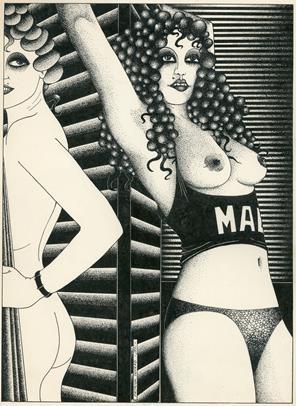But times and insights change. The past years, the Hendrik Conscience Heritage Library was able to acquire a substantial collection of pornographic publications dating from the late 1950s until the 1970s. These pornographic novels and magazines were usually sold ‘under the counter’, as they were forbidden by moral law. The so-called ‘under the counter-collection’ of the Hendrik Conscience Heritage Library, however fragmentary, is representative for the pornographic production just before, between and after the sexual revolution. It demonstrates the scale and socio-cultural impact of pornography. The collection has become even more thought-provoking in times of #MeToo: not only does it show social evolutions, but it also confronts us with the unconvenient truth that outdated heteronormative patterns turn out to be very much alive in our so-called egalitarian society.
The collection is interesting from various scholarly perspectives. From a historico-cultural and a sociological point of view, it sheds light on gender stereotypes and changing attitudes towards non-heterosexual relationships. Same sex erotic relations were a topic, but rather a marginal niche. Lesbian sex scenes were usually perceived through the male gaze, and pictured as an aberration which in due course should be cured by a viril male subject.
With respect to media studies, the pornographic collection demonstrates the emergence of the visual culture in periodical publications during the twentieth century. While erotic magazines were initially rather innocent, their content and covers – with the words ‘for adults’ added – became gradually more piquant. Their expansion culminated during the late 1960s. Magazines such as Sex Top and De Mascotte, published from 1960 onwards, for example, had a predominantly textual character at first and usually presented a short porn novel in a cheap format but without much engaging visuals. In due course, explicit covers, photo reportages, and erotic advertising suppressed textual contributions. From the eighties onwards, the market for pornographic novels and eventually magazines too, started to collapse in favour of porn movies, on VHS, DVD, and more recently, the internet.
 For literary scholars, the collection provokes questions concerning literary style and the margins of pulp and literature. As such, it connects with research on popular fiction and the margins of the literary. The collection reveals how pornographic pulp and literature interact, making it virtually impossible to maintain a clear distinction between both. An interesting case in this context is the Antwerp publisher-author Walter Soethoudt. Soethoudt, who published pornographic pulp under different imprints (e.g. Bison, Walter Soethoudt, De Dageraad, Juthro) and wrote porn novels under various pseudonyms (Art Ada, Winnetou Stradevarus), was a key figure in the dissemination of Flemish pornographic production in Flanders and the Netherlands during the sixties. However, he also sought literary recognition, by stimulating renowned literary authors to write for his publishing house and by planning the literary pornographic experiment Het voortplantingsoffensief. For this he collaborated with Flemish authors including C.C. Krijgelmans, Gust Gils, and Hugues C. Pernath.
For literary scholars, the collection provokes questions concerning literary style and the margins of pulp and literature. As such, it connects with research on popular fiction and the margins of the literary. The collection reveals how pornographic pulp and literature interact, making it virtually impossible to maintain a clear distinction between both. An interesting case in this context is the Antwerp publisher-author Walter Soethoudt. Soethoudt, who published pornographic pulp under different imprints (e.g. Bison, Walter Soethoudt, De Dageraad, Juthro) and wrote porn novels under various pseudonyms (Art Ada, Winnetou Stradevarus), was a key figure in the dissemination of Flemish pornographic production in Flanders and the Netherlands during the sixties. However, he also sought literary recognition, by stimulating renowned literary authors to write for his publishing house and by planning the literary pornographic experiment Het voortplantingsoffensief. For this he collaborated with Flemish authors including C.C. Krijgelmans, Gust Gils, and Hugues C. Pernath.
The erotic imagination also emerges in the works of established, prize-winning authors such as Hugo Claus, Louis Paul Boon, and Jef Geeraerts. In contrast to the Soethoudt-books, their works have been published by mainstream literary publishing houses such as De Bezige Bij, De Arbeiderspers, and Manteau, arising controversy but also literary approval. For these authors, the incorporation of explicit sex scenes functioned as a means to revolt against bourgeois society and conservative moral.
In its exhibition “Porno, pulp en literatuur”, the Hendrik Conscience Heritage Library unlocked this special and intriguing collection of pornographic and erotic literature and pulp magazines to the public. While the exhibition focuses on the 1950s to 1970s in Flanders, it simultaneously demonstrates that pornographic literature cannot be reduced to this time and space. In the collection of the Hendrik Conscience Heritage Library, much older works like the seventeenth-century manuscript Het Mengelmoes, show how the erotic imagination was deployed to arouse a select group of Antwerp readers as well as to criticize institutions such as the clergy. Other publications from the nineteenth century until the late 1960s and beyond, show how pornographic publications have been confronted with censorship, in more or less drastic ways. The exhibition ends with an insight in recent pornographic prints, such as porn novels written by and for women, erotic photo albums and glossy magazines. On top of that, the exhibition treats visitors to a complementary selection of characteristic Belgian erotic film fragments.
Further reading
- Karen Van Hove & Bart Vervaeck (ed.), Gewaagde geschriften. Interacties tussen pornografie en literatuur in Vlaanderen en Nederland (Gent: Academia Press, 2019).
- Linda Williams, Hard Core. Power, Pleasure, and the ‘Frenzy of the Visible’ (Berkeley/Los Angeles: University of California Press, 1989).



